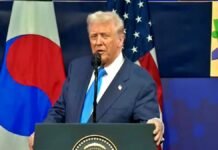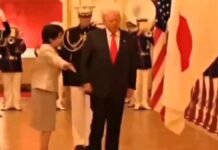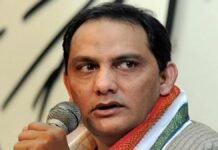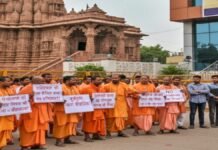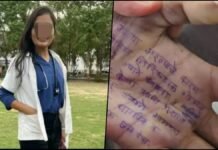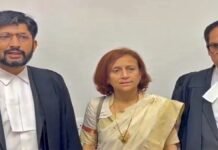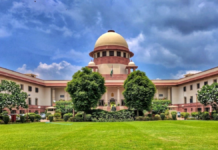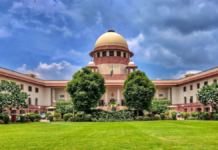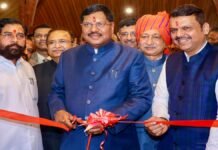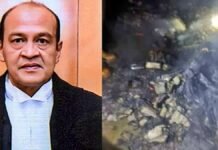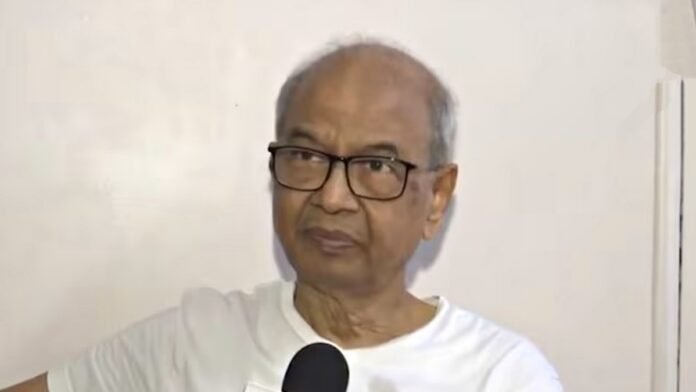
Key Points:
- 72-year-old lawyer Rakesh Kishore attempted to throw shoe at Chief Justice of India B.R. Gavai on Monday at 11:35 AM
- Security personnel apprehended Kishore immediately in Supreme Court Courtroom 1 and handed him to police
- Kishore claims he was hurt by CJI’s remarks during September 16 PIL hearing where Gavai allegedly mocked religious sentiments
- Accused enrolled with Delhi Bar Council in 2009, holds memberships in Supreme Court Bar Association, Shahdara Bar Association
- Kishore shows no remorse, states willingness to go to jail despite family anger
- Accused clarifies no political party affiliation; resides in Mayur Vihar, Delhi
- CJI Gavai instructed officials to let the accused go after security intervention
- Kishore possessed valid court entry documents and Bar Council of India credentials
New Delhi: A dramatic security breach unfolded in India’s apex court on Monday when a 72-year-old senior lawyer attempted to throw a shoe at Chief Justice of India B.R. Gavai during court proceedings. The incident, which occurred at approximately 11:35 AM in Courtroom 1 of the Supreme Court, has raised serious questions about judicial security and the decorum expected within the country’s highest legal institution.
Incident Details and Immediate Response
The shocking episode transpired during routine court hearings when Rakesh Kishore, a practicing lawyer with over 15 years of bar council enrollment, suddenly removed his shoe and attempted to hurl it toward the Chief Justice’s bench. Alert security personnel stationed in the courtroom immediately intervened, preventing the shoe from reaching its intended target and swiftly apprehending Kishore before any harm could occur.
Court officials present during the incident immediately sought directions from CJI Gavai on how to proceed with the disruptive lawyer. However, in an unexpected display of restraint, the Chief Justice chose to ignore the commotion and, according to reports, instructed security personnel to release Kishore and let him go. This measured response prevented further escalation and maintained the dignity of court proceedings despite the provocation.
Following the security intervention, Kishore was escorted out of the courtroom and subsequently handed over to Delhi Police officials for further investigation. The incident temporarily disrupted proceedings in one of the Supreme Court’s most important courtrooms, where constitutional matters and significant cases are regularly heard.
Profile of the Accused Lawyer
Rakesh Kishore, the lawyer behind this unprecedented incident, is not a novice to the legal profession. The 72-year-old practitioner enrolled with the Delhi Bar Council in 2009 and has since maintained active membership in multiple legal associations. His credentials include memberships in the prestigious Supreme Court Bar Association (SCBA), Shahdara Bar Association, and Delhi Bar Council—all legitimate professional bodies that regulate legal practice in their respective jurisdictions.
Kishore resides in the Mayur Vihar area of East Delhi and is known within legal circles as a senior member of various bar associations. At the time of the incident, he possessed valid entry documents required for Supreme Court access, along with his Bar Council of India identification card and temporary Supreme Court Bar Association membership certificate. These credentials had enabled him to enter the court premises without raising initial security concerns.
Despite his professional standing and decades of legal experience, Kishore’s actions on Monday morning have jeopardized his career and reputation within the legal fraternity. The incident marks a stark departure from the professional conduct expected of senior lawyers who are supposed to uphold the dignity of courts and judicial institutions.
Motivation Behind the Attack
Speaking to news agency ANI following the incident, Rakesh Kishore provided his rationale for the shocking behavior, claiming he was “deeply hurt” by remarks made by CJI Gavai during a Public Interest Litigation (PIL) hearing on September 16. According to Kishore’s account, someone had filed a PIL in the Chief Justice’s court on that date, and during proceedings, Justice Gavai allegedly made comments that Kishore perceived as mocking and disrespectful toward religious sentiments.
Kishore specifically alleged that the Chief Justice told the petitioner to “go and pray to the idol to fix his own head,” which the senior lawyer interpreted as ridicule of religious practices and beliefs. He further claimed that this same Chief Justice delivers judgments with great discretion and sensitivity in cases involving other religious communities, suggesting a perceived double standard in judicial approach.
The accused lawyer also referenced the Haldwani case in Uttarakhand as an example of what he views as differential treatment of religious matters by the judiciary. The Haldwani case involved controversial issues related to religious structures and communal tensions, making it a sensitive matter in India’s complex religious landscape.
No Remorse, Family Disapproval
In a striking display of defiance, Kishore expressed no regret for his actions despite the serious legal and professional consequences he faces. When questioned about his willingness to accept punishment, he stated, “It would be better if I go to jail. My family is very angry; they don’t understand why I did this.”
This statement reveals a disconnect between Kishore’s personal convictions and his family’s understanding of his actions. While his family members are reportedly furious about his behavior and struggle to comprehend his motivations, Kishore appears resolute in his belief that his actions were justified by what he perceives as judicial impropriety.
The lawyer also took pains to clarify that he has no affiliation with any political party, apparently anticipating speculation that his actions might have been politically motivated or coordinated with opposition groups. This disclaimer suggests awareness that the incident could be interpreted through a political lens given India’s often-polarized discourse around judicial decisions and religious matters.
Legal and Professional Implications
Kishore’s actions constitute serious offenses under multiple legal provisions. Attempting to attack a sitting Chief Justice of India represents contempt of court, assault, and potentially violates security laws protecting constitutional functionaries. The Delhi Police are expected to file formal charges that could result in substantial imprisonment if convicted.
Beyond criminal prosecution, Kishore faces severe professional consequences from bar associations and regulatory bodies. The Bar Council of India and state bar councils have established codes of conduct requiring lawyers to maintain court dignity and respect judicial authority. Violations of these professional standards can result in suspension or permanent disbarment, effectively ending a legal career.
The Supreme Court Bar Association is also likely to take disciplinary action, potentially revoking Kishore’s membership and barring him from future court access. Such professional sanctions would prevent him from practicing in the Supreme Court even if he avoids lengthy imprisonment.
Security Concerns and Court Protection
This incident has exposed potential vulnerabilities in Supreme Court security protocols despite multiple layers of protection. The fact that a lawyer with valid credentials could come dangerously close to physically attacking the Chief Justice raises questions about screening procedures and in-court security arrangements.
Supreme Court security typically involves document verification at entry points, metal detectors, bag screening, and armed personnel stationed throughout the premises. However, lawyers with valid bar council credentials generally receive expedited entry based on professional trust and practical necessity for court functioning. Kishore’s actions may prompt reassessment of these protocols to balance access requirements with security imperatives.
The incident also highlights the challenges of protecting judicial officers from individuals who hold legitimate court access privileges. Unlike external threats from militants or protesters, insider threats from disgruntled lawyers or litigants are harder to detect and prevent through conventional security measures.
Judicial Response and Restraint
CJI Gavai’s decision to instruct officials to release Kishore rather than pursue immediate punitive action demonstrates remarkable judicial restraint. This measured response reflects the judiciary’s traditional reluctance to appear vindictive or personally affected by provocations, maintaining the institutional dignity that transcends individual incidents.
However, this restraint does not preclude subsequent legal action or professional disciplinary proceedings against Kishore. The Delhi Police investigation will proceed independently of the Chief Justice’s personal response, and bar associations will likely initiate their own inquiries into professional misconduct.
Broader Context of Judicial Tensions
The incident occurs against a backdrop of occasional tensions between the bar and bench over various issues, including case management, judicial appointments, and courtroom conduct. While the vast majority of lawyer-judge interactions remain professional and respectful, isolated incidents of conflict periodically surface.
Kishore’s grievance regarding perceived differential treatment of religious matters reflects broader debates in Indian society about judicial approach to sensitive communal issues. Courts regularly navigate complex terrain balancing constitutional secularism, religious freedom, and community sentiments—decisions that inevitably draw criticism from various quarters regardless of outcomes.
Unprecedented Nature of Attack
Physical attacks or attempted attacks on sitting Supreme Court judges are exceptionally rare in Indian judicial history. The Supreme Court, as the guardian of the Constitution and final arbiter of legal disputes, commands tremendous respect and institutional protection. Breaches of court decorum occasionally occur through verbal outbursts or procedural violations, but physical violence attempts represent extraordinary departures from legal profession norms.
This incident will likely be studied as a case example in discussions about judicial security, professional ethics, and the boundaries of legitimate dissent within legal systems. While lawyers have every right to criticize judicial decisions through proper channels including review petitions, academic commentary, and public discourse physical violence can never constitute acceptable expression of disagreement in democratic societies governed by rule of law.
The coming days will reveal the full legal and professional consequences facing Rakesh Kishore as investigations proceed and disciplinary bodies deliberate appropriate sanctions for this unprecedented breach of judicial security and professional conduct.






